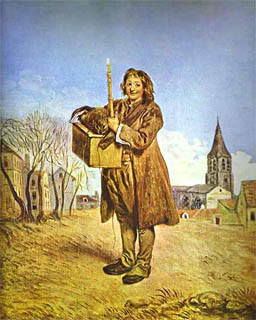Tomorrow is Groundhog Day, a festival now mostly celebrated in America, although one that has it has its roots in Europe, in rites associated with Candlemas. In medieval Germany it was believed that if a certain hibernating animal – sometimes a hedgehog, sometimes a marmot, or groundhog – saw its own shadow on Candlemas Day, it would retreat back to its burrow, thus presaging “a second winter” rather than the early advent of spring. The focus of the modern cult of Groundhog Day is Philadelphia, where powers of prophecy are currently attributed to a groundhog named “Punxsutawney Phil”. This week’s picture is one of relatively few Old Master paintings to feature a species of groundhog: Jean-Antoine Watteau’s Savoyard with a Marmot, painted in around 1716.
Watteau is famous as the painter of fetes champetres: languid, erotically charged pastorals in which finely dressed men and women commune with themselves, and one another, in what often seems an ambigous or melancholic way. But Watteau also took a keen interest in the various picturesque characters that he encountered in the course of his daily life, first as an apprentice artist in his native town of Valenciennes, later as a successful painter and member of the French Academy in Paris. He made many beautiful chalk drawings of soldiers and monks, of exotically clothed Persian visitors to France and of ragged street urchins. He seems to have been particularly drawn to the subject of Savoyards, poor people from the mountainous region of the Haute-Savoie who spent much of the winter months wandering through France, turning their hands to all kinds of work, selling curiosities or entertaining whatever audience they could find with peep-shows or trained animals. Savoyard with a Marmot is one of just a few, finished oil-paintings of such subjects....


